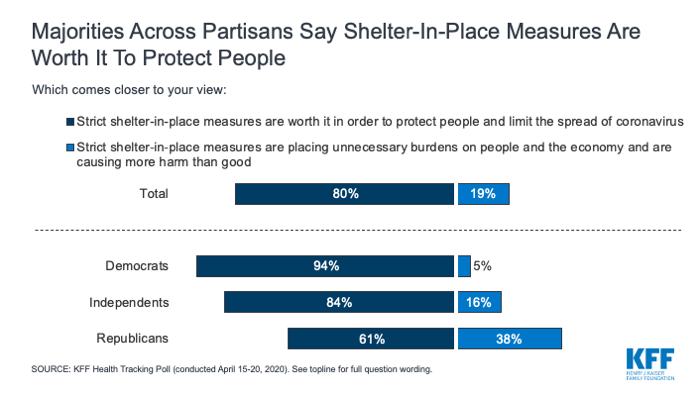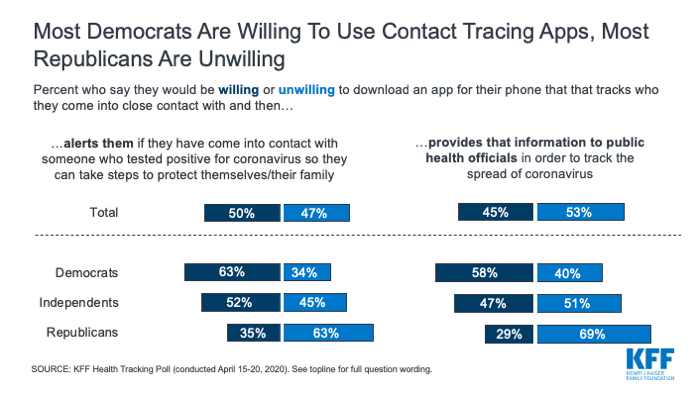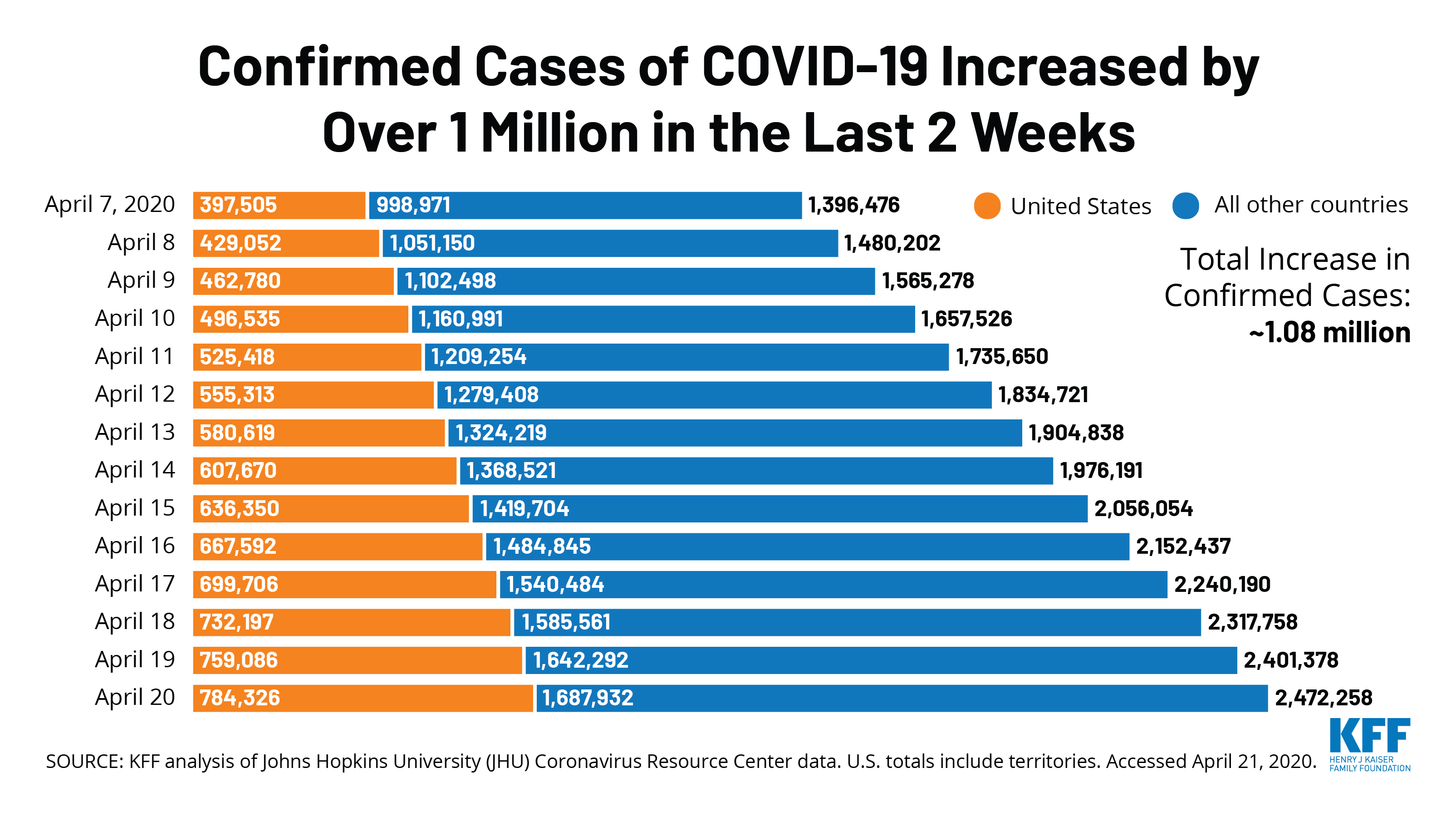How Many Adults Are at Risk of Serious Illness If Infected with Coronavirus? Updated Data
View and download a PDF of this Data Note.
As the number of people in the U.S. with coronavirus disease (COVID-19) continues to grow, there is increasing concern for adults who have a higher risk of developing serious illness if they are infected. The majority of people who become infected are expected to be asymptomatic or recover without needing special treatment, according to the World Health Organization. However, based on the most current information made available by the Centers for Disease Control and Prevention (CDC), older people and younger adults with serious medical conditions, such as heart disease, diabetes, lung disease, asthma and obesity have a greater risk of becoming severely ill if they get infected with coronavirus. CDC has issued specific guidance for people who fall into these categories.
To inform discussions about the challenges associated with coronavirus in the U.S., we first analyzed data from the 2018 Behavioral Risk Factor Surveillance System (BRFSS) to estimate the total number of adults nationwide, and by state, who have an elevated risk of serious illness if they are infected with coronavirus. CDC’s understanding of risk factors continues to evolve as the disease spreads, and more is learned about the effects of the coronavirus on different populations. We have therefore updated our previously published analysis to reflect a revised definition from the CDC of adults who are at higher risk of serious illness if they get infected with coronavirus. Our updated definition of high risk now includes: older adults (ages 65 or older, rather than 60 and older) and adults between the ages of 18 and 64 with heart disease, chronic obstructive pulmonary disease (COPD), uncontrolled asthma, diabetes, or a BMI greater than 40. To avoid overestimating the number and share of adults at higher risk of serious illness, our revised analysis does not include people with cancer; this is because BRFSS asks if respondents have ever had cancer, whereas CDC at-risk guidelines are limited to people who are currently immunocompromised, including cancer patients in treatment. We have also updated our weighting methodology to provide more robust state-level estimates of the number of adults at higher risk. See Methods for more information.
Key Findings
- About four in ten adults (37.6%) ages 18 and older in the U.S. (92.6 million people) have a higher risk of developing serious illness if they become infected with coronavirus, due to their older age (65 and older) or health condition (Figure 1; Table 1).
- Just over half of those at higher risk of developing a serious illness are ages 65 and older (55.2% or 51.1 million adults); however, the remaining 41.4 million adults ages 18-64 are at risk due to an underlying medical condition.
- The share of adults ages 18 and older who have a higher risk of developing a more serious illness varies across the country, ranging from 49.3 percent (West Virginia) to 30 percent (Utah).
- In some of the states with the highest number of reported coronavirus cases thus far, the share of adults at high risk of serious illness if infected is relatively high: Louisiana and Florida (at 42.1 percent, each) and Michigan (41.2 percent).
- An estimated 5.1 million adults who are at higher risk of getting a serious illness if they become infected with coronavirus are uninsured.

–
–
–
–
Discussion
The majority of people who become infected with coronavirus are not expected to become seriously ill, but a large segment of the U.S. adult population – one third (37.6 percent) of adults ages 18 and older – have a higher risk of serious illness if they do become infected due to their age or underlying medical condition. One group particularly at risk are the 1.3 million people living in nursing homes in the US. As the number of people who test positive for coronavirus continues to rise, and as more is learned about the progression of illness and treatment among those who become seriously ill, the current set of risk factors available to estimate the size of the at-risk population is likely to be refined. Given the paucity of data at this stage of the pandemic, and the high stakes involved for people who do get seriously ill, these estimates confirm the need to take unprecedented efforts to minimize the spread of the coronavirus.
Methods
This brief analyzes data from the nationally-representative, cross-sectional 2018 Behavioral Risk Factor Surveillance System (BRFSS) of adults ages 18 and older living in the community. BRFSS is an ongoing, state-based, random-digit-dialed telephone survey of non-institutionalized civilian adults. The 2018 survey has over 430,000 respondents. Information about the BRFSS is available at http://www.cdc.gov/brfss/index.html. For this updated analysis, we calculated the number of people at risk of serious illness if they get infected with coronavirus, using BRFSS, and we controlled these estimates to the 2018 American Community Survey (ACS) to generate population counts by state and age. Because of its large sample size, the ACS is generally seen as providing reliable population estimates by state. This updated analysis reflects this change in weighting methodology. The weighted total population is about 3% less in the ACS than in BRFFSS.
The estimate of the percentage of adults at higher risk utilizes the BRFSS survey weights to account for the complex sampling design. Data exclude adults living in Guam or Puerto Rico. Data represent adults who report ever being told by a doctor that they have one of the listed conditions. To avoid overestimating the number and share of adults at higher risk of serious illness, our revised analysis does not include people with cancer; this is because BRFSS asks if respondents have ever had cancer, whereas CDC at-risk guidelines are limited to people who are currently immunocompromised, including cancer patients in treatment. Because the CDC guidelines suggest that those with moderate or severe asthma are at greater risk than those with mild asthma, we adjusted the overall total to account for the share with uncontrolled asthma, adjusting the overall total by 62 percent, based on CDC prevalence. The change in estimates from our previous analysis are mainly attributable to the revised CDC at-risk guidelines.
| Table 1: Number of U.S. Adults At Higher Risk Of Serious Illness If Infected With Coronavirus | ||||||||||
| Total, adults ages 18 and older | Adults under age 65. | Adults age 65 and older | ||||||||
| State | Total number, adults 18 and older | Number at risk, adults 18 and older | At-risk adults, as a share of all adults ages 18 and older | Total number, adults under age 65 | Number at risk due to health conditions, adults under age 65 | Share of adults under age 65 at risk | Total number, adults age65 and older | Older adults, as a share of all at-risk adults | ||
| Overall | 246,402,480 | 92,560,223 | 37.60% | 195,281,293 | 41,439,036 | 21.20% | 51,121,187 | 55.20% | ||
| Alaska | 527,792 | 172,913 | 32.80% | 442,335 | 87,456 | 19.80% | 85,457 | 49.40% | ||
| Alabama | 3,684,158 | 1,588,905 | 43.10% | 2,873,170 | 777,917 | 27.10% | 810,988 | 51.00% | ||
| Arkansas | 2,231,289 | 971,477 | 43.50% | 1,742,217 | 482,405 | 27.70% | 489,072 | 50.30% | ||
| Arizona | 5,389,431 | 2,107,495 | 39.10% | 4,143,554 | 861,618 | 20.80% | 1,245,877 | 59.10% | ||
| California | 29,879,585 | 9,952,647 | 33.30% | 24,302,948 | 4,376,010 | 18.00% | 5,576,637 | 56.00% | ||
| Colorado | 4,301,492 | 1,345,398 | 31.30% | 3,506,700 | 550,606 | 15.70% | 794,792 | 59.10% | ||
| Connecticut | 2,739,381 | 985,861 | 36.00% | 2,148,446 | 394,926 | 18.40% | 590,935 | 59.90% | ||
| District Of Columbia | 542,174 | 172,398 | 31.80% | 459,618 | 89,842 | 19.50% | 82,556 | 47.90% | ||
| Delaware | 739,951 | 305,395 | 41.30% | 562,058 | 127,502 | 22.70% | 177,893 | 58.30% | ||
| Florida | 16,683,102 | 7,018,513 | 42.10% | 12,389,357 | 2,724,768 | 22.00% | 4,293,745 | 61.20% | ||
| Georgia | 7,748,091 | 2,803,400 | 36.20% | 6,321,701 | 1,377,010 | 21.80% | 1,426,390 | 50.90% | ||
| Hawaii | 1,056,723 | 412,878 | 39.10% | 798,667 | 154,822 | 19.40% | 258,056 | 62.50% | ||
| Iowa | 2,336,881 | 862,351 | 36.90% | 1,819,010 | 344,480 | 18.90% | 517,871 | 60.10% | ||
| Idaho | 1,282,329 | 464,522 | 36.20% | 1,006,426 | 188,619 | 18.70% | 275,903 | 59.40% | ||
| Illinois | 9,623,149 | 3,482,300 | 36.20% | 7,697,443 | 1,556,594 | 20.20% | 1,925,706 | 55.30% | ||
| Indiana | 4,955,934 | 1,976,552 | 39.90% | 3,940,531 | 961,149 | 24.40% | 1,015,403 | 51.40% | ||
| Kansas | 2,124,795 | 807,193 | 38.00% | 1,683,235 | 365,633 | 21.70% | 441,560 | 54.70% | ||
| Kentucky | 3,341,735 | 1,455,749 | 43.60% | 2,630,671 | 744,685 | 28.30% | 711,064 | 48.80% | ||
| Louisiana | 3,435,791 | 1,445,420 | 42.10% | 2,736,213 | 745,842 | 27.30% | 699,578 | 48.40% | ||
| Massachusetts | 5,318,415 | 1,837,581 | 34.60% | 4,215,360 | 734,526 | 17.40% | 1,103,055 | 60.00% | ||
| Maryland | 4,556,875 | 1,690,631 | 37.10% | 3,650,537 | 784,293 | 21.50% | 906,338 | 53.60% | ||
| Maine | 1,060,936 | 451,409 | 42.50% | 792,994 | 183,467 | 23.10% | 267,942 | 59.40% | ||
| Michigan | 7,649,977 | 3,152,031 | 41.20% | 5,973,998 | 1,476,052 | 24.70% | 1,675,979 | 53.20% | ||
| Minnesota | 4,211,344 | 1,428,307 | 33.90% | 3,354,163 | 571,126 | 17.00% | 857,181 | 60.00% | ||
| Missouri | 4,590,784 | 1,860,608 | 40.50% | 3,590,211 | 860,035 | 24.00% | 1,000,573 | 53.80% | ||
| Mississippi | 2,185,597 | 929,387 | 42.50% | 1,724,625 | 468,415 | 27.20% | 460,972 | 49.60% | ||
| Montana | 813,505 | 317,546 | 39.00% | 615,520 | 119,561 | 19.40% | 197,985 | 62.30% | ||
| North Carolina | 7,785,717 | 3,038,856 | 39.00% | 6,137,620 | 1,390,759 | 22.70% | 1,648,097 | 54.20% | ||
| North Dakota | 560,523 | 194,056 | 34.60% | 450,954 | 84,487 | 18.70% | 109,569 | 56.50% | ||
| Nebraska | 1,404,355 | 514,118 | 36.60% | 1,112,641 | 222,404 | 20.00% | 291,714 | 56.70% | ||
| New Hampshire | 1,059,120 | 428,938 | 40.50% | 821,964 | 191,782 | 23.30% | 237,156 | 55.30% | ||
| New Jersey | 6,799,427 | 2,354,252 | 34.60% | 5,396,351 | 951,176 | 17.60% | 1,403,076 | 59.60% | ||
| New Mexico | 1,575,314 | 619,893 | 39.40% | 1,211,046 | 255,625 | 21.10% | 364,268 | 58.80% | ||
| Nevada | 2,307,514 | 833,620 | 36.10% | 1,833,570 | 359,676 | 19.60% | 473,944 | 56.90% | ||
| New York | 15,028,787 | 5,550,169 | 36.90% | 11,914,579 | 2,435,961 | 20.40% | 3,114,208 | 56.10% | ||
| Ohio | 8,817,672 | 3,506,796 | 39.80% | 6,891,542 | 1,580,666 | 22.90% | 1,926,130 | 54.90% | ||
| Oklahoma | 2,879,096 | 1,175,713 | 40.80% | 2,280,666 | 577,283 | 25.30% | 598,430 | 50.90% | ||
| Oregon | 3,257,427 | 1,297,341 | 39.80% | 2,528,112 | 568,026 | 22.50% | 729,315 | 56.20% | ||
| Pennsylvania | 9,798,951 | 3,898,304 | 39.80% | 7,547,656 | 1,647,009 | 21.80% | 2,251,295 | 57.80% | ||
| Rhode Island | 814,843 | 312,092 | 38.30% | 639,889 | 137,138 | 21.40% | 174,954 | 56.10% | ||
| South Carolina | 3,838,837 | 1,590,048 | 41.40% | 2,957,890 | 709,101 | 24.00% | 880,947 | 55.40% | ||
| South Dakota | 639,915 | 226,086 | 35.30% | 500,965 | 87,136 | 17.40% | 138,950 | 61.50% | ||
| Tennessee | 5,105,824 | 2,121,941 | 41.60% | 4,031,127 | 1,047,244 | 26.00% | 1,074,697 | 50.60% | ||
| Texas | 20,715,876 | 7,199,553 | 34.80% | 17,205,161 | 3,688,838 | 21.40% | 3,510,715 | 48.80% | ||
| Utah | 2,189,374 | 657,278 | 30.00% | 1,846,133 | 314,037 | 17.00% | 343,241 | 52.20% | ||
| Virginia | 6,343,962 | 2,275,390 | 35.90% | 5,048,192 | 979,620 | 19.40% | 1,295,770 | 56.90% | ||
| Vermont | 490,326 | 191,781 | 39.10% | 371,176 | 72,631 | 19.60% | 119,150 | 62.10% | ||
| Washington | 5,733,155 | 2,013,681 | 35.10% | 4,590,384 | 870,910 | 19.00% | 1,142,771 | 56.80% | ||
| Wisconsin | 4,415,638 | 1,612,619 | 36.50% | 3,459,881 | 656,862 | 19.00% | 955,757 | 59.30% | ||
| West Virginia | 1,397,752 | 689,770 | 49.30% | 1,045,095 | 337,113 | 32.30% | 352,657 | 51.10% | ||
| Wyoming | 431,859 | 157,117 | 36.40% | 336,991 | 62,249 | 18.50% | 94,868 | 60.40% | ||
| NOTE: Data includes adults ages 18 and older; excludes adults living in nursing homes and other institutional settings.SOURCE: KFF analysis of 2018 Behavioral Risk Factor Surveillance System. | ||||||||||


